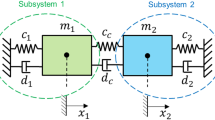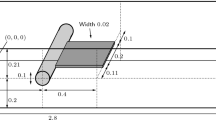Abstract
Standard coupling approaches for simulating coupled MBS/FEM systems may entail enormous CPU times in order to achieve a stable and accurate solution. To stabilize and speed up the solution process, semi-implicit coupling approaches can be applied successfully. In literature, semi-implicit coupling approaches have been introduced, where Jacobian information is exchanged between the subsystems using partial derivatives with respect to the state vectors of the subsystems. The drawback of these methods is that the numerical calculation of the Jacobians with respect to the whole state vector of the subsystems is very time-consuming. The key idea of the semi-implicit coupling technique presented here is to reduce the computational effort by using Jacobian information only with respect to the coupling variables.
The semi-implicit coupling technique introduced here is exemplarily applied for coupling a commercial MBS code with a commercial FEM code. As a practical example, we consider a hybrid nonlinear rotor/bearing model of a high-speed turbine. The rotor is modeled as a flexible multibody system. For calculating the bearing reactions, a finite element discretization of Reynolds fluid film equation is applied which yields the pressure distribution in the fluid films of the hydrodynamic bearings. Both codes are coupled via interprocess communication (IPC). A very time-efficient implementation of the semi-implicit coupling approach can be accomplished by a parallelization on multiple CPUs.
Similar content being viewed by others
References
Ambrosio J., Pombo J., Rauter F., Pereira M.: A memory based communication in the co-simulation of multibody and finite element codes for pantograph-catenary interaction simulation. Comput. Methods Appl. Sci. 12, 231–252 (2008)
Andreykiv A., Rixen D.J.: Numerical modelling of electromechanical coupling using fictitious domain and level set methods. Int. J. Numer. Methods Eng. 80, 478–506 (2007)
Arnold, J., Einarsson, G., Schütte, A.: Multibody simulation of an aeroelastic delta wing in roll manoeuvre. In: Proceedings of ICAS 2006. Hamburg (2006)
Arnold, M.: Multi-rate time integration for large scale multibody system models. In: P. Eberhard (Ed.) IUTAM Symposium on Multiscale Problems in Multibody System Contacts, pp. 1–10. Springer, Berlin (2007)
Arnold M., Simeon B.: Pantograph and catenary dynamics: a benchmark problem and its numerical solution. Appl. Numer. Math. 34, 345–362 (2000)
Baines N.C.: Fundamentals of Turbocharging. Concepts NREC, USA (2005)
Bathe K.J.: Finite-Elemente-Methoden, 2 edn. Springer, Berlin (2007)
Bathe K.J., Zhang H.: Finite element developments for general fluid flows with structural interactions. Int. J. Numer. Methods Eng. 60, 213–232 (2004)
Birken, P., Quint, K.J., Hartmann, S., Meister, A.: A time-adaptive fluid-structure interaction method for thermal coupling. Comput. Visual. Sci. (2010). doi:10.1007/s00791-010-0150-4
Boyaci, A., Seemann, W., Proppe, C.: Bifurcation analysis of a turbocharger rotor supported by floating ring bearings. In: Proceedings of IUTAM Symposium on Emerging Trends in Rotor Dynamics. Indian Institute of Technology, Delhi (2009)
Brenan K.E., Campbell S.L., Petzold L.R.: Numerical Solution of Initial-Value Problems in Differential-Algebraic Equations, 2 edn. SIAM, Philadelphia (1996)
Burrage K.: Parallel and Sequential Methods for Ordinary Differential Equations (Numerical Mathematics and Scientific Computation). Oxford University Press, USA (1995)
Busch, M., Schweizer, B.: Numerical stability and accuracy of different co-simulation techniques: Analytical investigations based on a 2-DOF test model. In: Proceedings of The 1st Joint International Conference on Multibody System Dynamics. Lappeenranta (2010)
Cameron A., Ettles C.M.M.: Basic Lubrication Theory, 3 edn. Ellis Horwood, Chichester (1981)
Carrarini A.: Coupled multibody-aerodynamic simulation of high-speed trains manoeuvres. Proc. Appl. Math. Mech. (PAMM) 2, 114–115 (2003)
Carstens V., Kemme R., Schmitt S.: Coupled simulation of flow-structure interaction in turbomachinery. Aerospace Sci. Technol. 7, 298–306 (2003)
Craig R., Bampton M.: Coupling of substructures for dynamics analysis. AIAA J. 6, 1313–1319 (1968)
Dietz, S., Hippmann, G., Schupp, G.: Interaction of vehicles and flexible tracks by cosimulation of multibody vehicle systems and finite element track models. In: 17th Symposium Dynamics of Vehicles on Roads and Tracks IAVSD 2001, Copenhagen (2001)
Dietz S., Netter H., Sachau D.: Fatigue life prediction of a railway bogie under dynamic loads through simulation. Vehicle Syst. Dyn. Int. J. Vehicle Mech. Mobility 29, 385–402 (1998)
Finol, E.A., Martino, E.S.D., Vorp, D.A., Amon, C.H.: Fluid-structure interaction and structural analyses of an aneurysm model. In: Proceedings of the 2003 Summer Bioengineering Conference SBC2003. Key Biscayne (2003)
Goenka P.K.: Dynamically loaded journal bearings: finite element method analysis. Trans. ASME J. Tribol. 106, 429–439 (1984)
Greiff, M., Bala, U.B., Mathis, W.: Hybrid numerical simulation of micro electro mechanical systems. In: Progress in Electromagnetics Research Symposium 2006, Cambridge (2006)
Hauck, A.: Numerical simulation of coupled electro-mechanical systems using the finite element method. In: CSE Conference 2005, Orlando (2005)
Heckmann A., Arnold M., Vaculin O.: A modal multifield approach for an extended flexible body description in multibody dynamics. Multibody Syst. Dyn. 13, 299–322 (2005)
Hinrichsen D., Pritchard A.J.: Mathematical Systems Theory I: Modelling, State Space Analysis, Stability and Robustness, 1 edn. Springer, Heidelberg (2005)
Kelley C.: Solving Nonlinear Equations with Newton’s Method. Siam, Thailand (2003)
Koutsovasilis P., Quarz V., Beitelschmidt M.: Standard input data for FEM-MBS coupling: importing alternative model reduction methods into SIMPACK. Math. Comput. Model. Dyn. Syst. 15, 51–68 (2009)
Kübler R., Schiehlen W.: Two methods of simulator coupling. Math. Comput. Model. Dyn. Syst. 6, 93–113 (2000)
Liu F., Cai J., Zhu Y.: Calculation of Wing Flutter by a coupled fluid-structure method. J. Aircraft 38, 334–342 (2001)
Penrose J.M.T., Staples C.J.: A time-adaptive fluid-structure interaction method for thermal coupling. Int. J. Numer. Methods Eng. 40, 467–478 (2002)
Schweizer B.: Oil Whirl, Oil Whip and Whirl/Whip synchronization occurring in rotor systems with full-floating ring bearings. J. Nonlinear Dyn. 57, 509–532 (2009)
Schweizer B.: Total instability of turbocharger rotors—physical explanation of the dynamic failure of rotors with full-floating ring bearings. J. Sound Vib. 328, 156–190 (2009)
Schweizer B.: Dynamics and stability of automotive turbochargers. Arch. Appl. Mech. 80, 1017–1043 (2010)
Shabana A.A.: Dynamics of Multibody Systems, 2 edn. Wiley, London (1998)
Strehmel K., Weiner R.: Numerik gewöhnlicher Differentialgleichungen. Teubner, Stuttgart (1995)
Szeri A.Z.: Fluid Film Lubrication: Theory and Design. Cambridge University Press, Cambridge (2005)
Tanaka M., Hori Y.: Stability characteristics of floating bush bearings. ASME J. Lubr. Technol. 94, 248–259 (1972)
Simpack AG: SIMPACK Documentation (2009) http://www.simpack.com
Veitl A., Arnold M.: Coupled simulation of multibody systems and elastic structures. In: Ambrósio, J.A.C., Schiehlen, W. (eds) Advances in Computational Multibody Dynamics, pp. 635–644. IDMEC/IST, Lisbon (2001)
Wauer J., Schweizer B.: Dynamics of rotating thermoelastic disks with stationary heat source. Appl. Math. Comput. 215, 4272–4279 (2010)
Wünsche S., Clauß C., Schwarz P., Winkler F.: Electro-thermal circuit simulation using simulator coupling. IEEE Trans. Very Large Scale Integr. (VLSI) Syst. 5, 277–282 (1997)
Author information
Authors and Affiliations
Corresponding author
Rights and permissions
About this article
Cite this article
Busch, M., Schweizer, B. Coupled simulation of multibody and finite element systems: an efficient and robust semi-implicit coupling approach. Arch Appl Mech 82, 723–741 (2012). https://doi.org/10.1007/s00419-011-0586-0
Received:
Accepted:
Published:
Issue Date:
DOI: https://doi.org/10.1007/s00419-011-0586-0




